Search Results for Tag: permafrost
Arctic winter: warm, wet, weird
Here in Germany, the winter has seemed strange enough. We had flowers in bloom at Christmas, and people sneezing with pollen allergies. Overall it was extremely mild. Now we are just having the odd flurry of sleet, with the magnolias getting ready to bloom and much of nature said to be three weeks ahead of schedule. But that is nothing compared to what’s been going on in the Arctic.
“The Old Normal is Gone”, is the headline of a piece on Slate by Eric Holthaus, sub-headed “February Shatters Global Temperature Records”. He says the record warmth is so dramatic he is prepared to comment using unofficial data, before the official data comes out mid-March. February 2016, he says was probably somewhere between 1.15 and 1.4 degrees Celsius warmer than the long-term average, and about 0.2 degrees above last month, which was itself a record-breaker. This, Holthaus calculates, means while it took us from the start of industrialization until last October to reach the first 1 degree C. of warming, we have now gone up an extra 0.4 degrees in just five months. Paris target 1.5 degrees maximum – here we come!
In the Arctic, this is particularly dramatic. Parts of the Arctic were more than 16 degrees Celsius warmer than “normal” for the month of February, which, Holthaus says, is more like June temperatures, although it would normally be the coldest month.
Svalbard, one of my favourite icy places, has averaged 10 degrees Celsius above normal this winter, with temperatures rising above the freezing mark on nearly two dozen days since December first.
Correspondingly, the Arctic sea ice has reached a record low maximum. Lars Fischer, writing in the German publication Spektrum der Wissenschaft, notes that January already saw the smallest ice growth of the last ten years. In mid-February, he writes, satellite data showed the ice cover in some parts of the high north was almost a quarter of a million square kilometers less than ever before on this date. This lasted two weeks, than the ice grew a little last week, to draw equal with the previous all time low for a first of March. New ice will be much thinner than the old multi-year ice, a trend that has been increasing.
New satellite data
Researchers are using a new technique to gain data about the thinning ice pack in real time. An article in Nature, “Speedier Arctic data as warm winter shrinks sea ice”, describes a new tool to track changes as they happen and provide near real time estimates of ice thickness from the European Space Agency’s CryoSat-2 satellite. Previously, there was a time lag of at least a month.

Satellite data is revolutionizing what we know about the Arctic ice. The news is not good. (Pic. I.Quaile, Tromso)
Natural fluctuation, el Nino or human-made climate change?
Of course there are those who say fluctuation is natural in the Arctic. But this year, this fluctuation is extreme. Some researchers say the melt season started a whole month too early. Certainly, at this time, the Arctic should be in the grip of winter.
Fischer titles his article “Absurd winter in the Arctic”. I’m not sure absurd is the best way of describing it. (It could actually seem quite logical if you look at the extent of extra warmth we have been creating with our greenhouse gas emissions). Looking at an article in the Independent by Geoffrey Lean, I see the term “absurdly warm”comes from the NSIDC, National Snow and Ice Data Centre in Boulder, Colorado. The “strangest ever” and “off the chart” are used by NSIDC director Mark Serreze and NOOA respectively. Those figure.
In December 2015, the high Arctic experienced a heatwave. We saw temperatures near the North Pole going above freezing point. January was the warmest month since the beginning of weather data. In February, parts of the Arctic were more than ten degrees warmer than the long-term average.
The Arctic Oscillation is partly to blame. It is currently such that warm air can make its way north. Strong Atlantic storms have been pressing the warm, moist air north into the High Arctic. But surely there can be no doubt that our human-made climate warming is playing a major role in all this?
It remains to be seen how the situation will develop as the spring sets in. Fisher notes that the last winter ice maximum extent was very low, but was not followed by a new record low in summer.
Eric Holthaus notes that although we are experiencing a record-setting El Nino, which “tends to boost global temperatures for as much as six or eight months beyond its wintertime peak”, this alone cannot be responsible for the temperature records.
He quotes scientific studies indicating that El Nino’s influence on global temperatures as a whole is likely small, and that its influence on the Arctic still isn’t well known.
“So what’s actually happening now is the liberation of nearly two decades’ worth of global warming energy that’s been stored in the oceans since the last major El Nino in 1998”, he writes.
“The old normal is gone”
Whatever the cause – this record warmth is a major event in our climate system. Holthaus quotes Peter Gleick, a climate scientist at the Pacific Institute in Oakland, California in his article title: “The old normal is gone”. “The old assumptions about what was normal are being tossed out the window”.
“We could now be right in the heart of a decade or more surge in global warming that could kick off a series of tipping points with far-reaching implications”, says Holthaus. Where have I heard this before?
Lean, in the independent, says two new studies by the Woods Hole Research Center in Massachusetts give new evidence of self-reinforcing feedback mechanisms. This is not new. How much more evidence do we need? Permafrost thaws, resulting in emissions of methane and CO2 from the soil. Melting ice means the reflective white surface is replaced by dark water, which absorbs heat.
So what are we doing about it? In interviews with experts from NGOs including Earthwatch and Germanwatch recently, various experts have been confirming my own feeling that the Paris Climate Agreement may have been a milestone, but not necessarily a turning point – unless climate action is taken very quickly.
I would like to be optimistic. But there is so much evidence suggesting that whatever we do, it is likely to come too late to save the Arctic as we know – knew – it for coming generations. Come on world, prove me wrong! Please!
Record permafrost erosion in Alaska bodes ill for Arctic infrastructure

At Point Barrow, the northernmost point in the USA, a whole village was lost to erosion (Pic: I.Quaile)
Sitting in my office on the banks of the river Rhine, I am trying to imagine what would happen if the fast-flowing river was eating into the river bank at an average rate of 19 metres per year. It would not belong before our broadcasting headquarters, the UN campus tower and the multi-story Posttower building collapsed, with devastating consequences.
Fortunately, Bonn is not built on permafrost, so we don’t have that particular concern.
Record erosion on riverbank
The record erosion German scientists have been measuring in Alaska probably hasn’t been making the headlines because it is happening in a very sparsely populated area, where no homes or important structures are endangered.
Nevertheless, it certainly provides plenty of food for thought, says permafrost scientist Jens Strauss from the Potsdam-based research unit of the Alfred Wegener Institute for Polar and Marine Research (AWI). He and an international team have measured riverbank, erosion rates which exceed all previous records along the Itkillik River in northern Alaska. In a study published in the journal Geomorphology, the researchers report that the river is eating into the bank at 19 metres per year in a stretch of land where the ground contains a particularly large quantity of ice.
“These results demonstrate that permafrost thawing is not exclusively a slow process, but that its consequences can be felt immediately”, says Strauss.
With colleagues from the USA, Canada and Russia, he investigated the river at a point where it cuts through a plateau, where the sub-surface consists to 80 percent of pure ice and to 20 percent of frozen sediment. In the past, the ground ice, which is between 13,000 and 50,000 years old, stabilized the riverbank zone. The scientists, who have been observing the location for several years, demonstrated that the stabilization mechanisms fail if two factors coincide. That happens when the river carries flowing water over an extended period, and where the riverbank consists of steep cliff, which has a front facing south, and is thus exposed to a lot of direct sunlight.
Minus 12C average no safeguard
The warmer water thaws the permafrost and transports the falling material away, and in spite of a mean annual temperature of minus twelve degrees Celsius, summer sunlight makes it warm enough to send lumps of ice and mud flowing down the slope, according to Michail Kanevskixy from the University of Alaska Fairbanks, lead author of the study.
Overall, between 2007 and 2011, the cliff – which is 700 metres long and 35 metres high – retreated up to 100 metres, resulting in the loss of 31,000 square metres of land area. That is a large area, around 4.3 football fields, the scientists calculate.
In August 2007, they also witnessed how fissures formed within a few days, up to 100 metres long and 13 metres deep.
“Such failures follow a defined pattern”, says Jens Strauss. “First, the river begins to thaw the cliff and scours an overhang at the base. From here, fissures form in the soil following the large ice columns. The block then disconnects from the cliff, piece by piece, and collapses”.
Infrastructure under threat
Although these spectacular events happened far from populated areas and infrastructure, the magnitude of the erosion gives cause for much concern, given the rate at which temperatures are increasing in the Arctic. The scientists want their information to be used in the planning of new settlements, power routes and transport links. They also stress that the erosion impairs water quality on the rivers, which are often used for drinking water.
But what about those areas of the High North where there are settlements and key infrastructure? Russia is starting to get very worried about the effects of increasing permafrost erosion.
Last month the country’s Minister of Natural Resources, Sergey Donsjkoy, expressed grave concern. The Independent Barents Observer quoted the Minister as saying, in an interview with RIA Novosti, he feared the thawing permafrost would undermine the stability of Arctic infrastructure and increase the likelihood of dangerous phenomena like sinkholes. Russia has important oil and gas installations in Arctic regions. Clearly, any damage would have considerable economic implications. There are also whole cities built on permafrost in the Russian north.
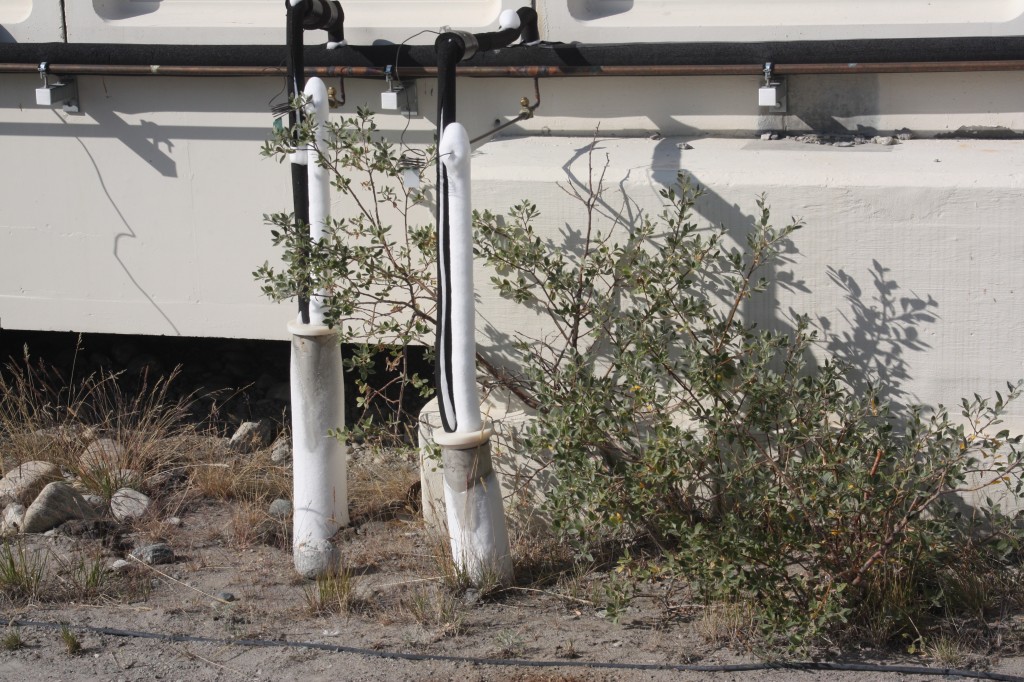
System to cool the foundations of a building on permafrost in Kangerlussuaq, Greenland (pic: I.Quaile)
High time to adapt
In 2014, I interviewed Hugues Lantuit, a coastal permafrost geomorphologist with the Alfred Wegener Institute for Polar and Marine Research, about an integrated database on permafrost temperature being set up as an EU project. He told me it would be very hard to halt this permafrost thaw, and stressed that permafrost underlies 44 percent of the land part of the northern hemisphere.
“The air temperature is warming in the Arctic, and we need to build and adapt infrastructure to these changing conditions. It’s very hard, because permafrost is frozen ground. It contains ice, and sometimes this ice is not distributed evenly under the surface. It’s very hard to predict where it’s going to be, and thus where the impact will be as the permafrost warms and thaws”.
I remember being shocked to see that people in Greenland were having to use refrigeration to keep the foundations of their buildings on permafrost stable. The scale of the problem is clearly much greater in cities like Yakutsk.
Then, of course comes the feedback problem, when thawing permafrost releases the organic carbon stored within it. Let me give the last word to Hugues Lantuit:
“This is a major issue, because it contains a lot of what we call organic carbon, and that is stored in the upper part of permafrost. And if that warms, the carbon is made available to microorganisms that convert it back to carbon dioxide and methane. And we estimate right now that there is twice as much organic carbon in permafrost as there is in the atmosphere. So you can see the scale of the potential impact of warming in the Arctic.”
Paris: A COP-out for Arctic Peoples?
As I write, the climate negotiations have been extended into Saturday. Same procedure as every year? While I still hope the seemingly never-ending bickering will result in a document which will at least signal the end of the fossil fuels era, I cannot help feeling a sense of sadness and regret, that this is all way too late for the Arctic, as I discussed in the last blog post. And I wonder how all this feels to indigenous folk living in the High North, as they see their traditional lifestyles melting away.
On a recent edition of DW’s Living Planet programme, Lakeidra Chavis reported on the effect of melting permafrost on indigenous communities in Alaska. Chatting to a colleague in between times about the story, she told me how moved she was to hear how skulls had been washed up in a river as the permafrost at a burial site thawed.
Climate change impacts the present, future – and past
I had a kind of déjà vu feeling. Back in 2008, in those early days of the Ice Blog, I travelled out to Point Barrow, the northernmost point in the USA, with archaeologist Anne Jensen. We visited the site where a village had had to be re-located because of coastal erosion, with melting permafrost and dwinding sea ice. She told me how she was called up by distraught locals in the middle of the night and asked to help recover the remains of their ancestors before they were washed into the ocean. My colleague here in Bonn was surprised to hear that I had conducted that interview back in 2008. How could this have been known at that time already, yet so little publicized?
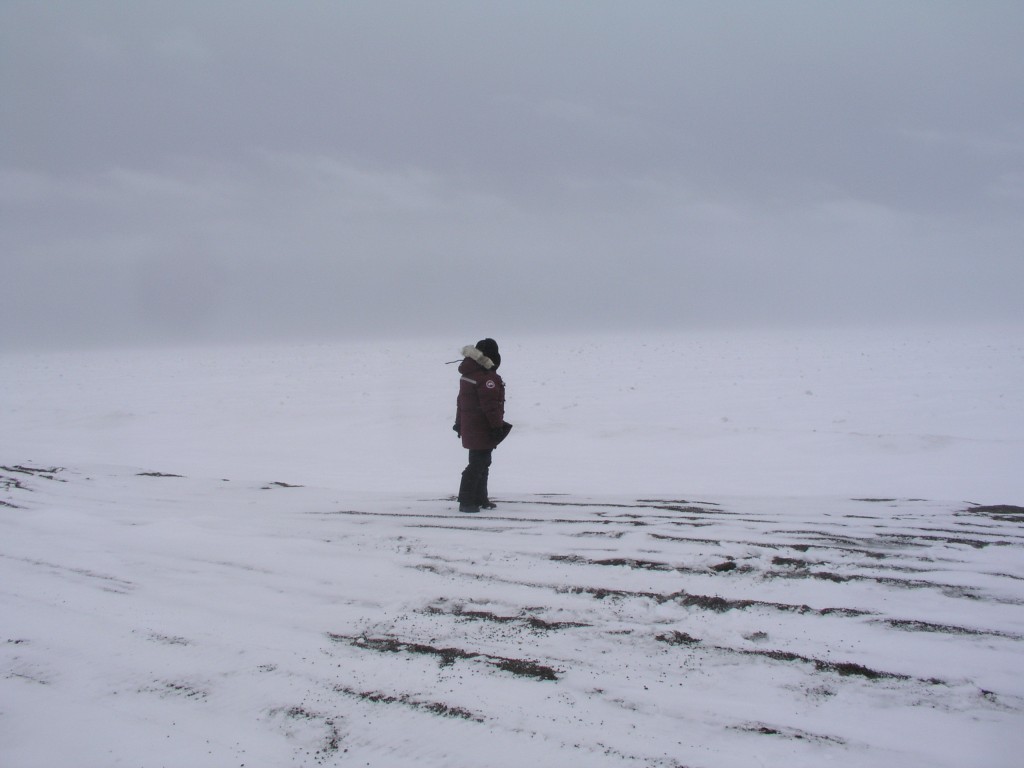
Climate change impacts: Jensen at the site of a lost Inupiat village at Point Barrow, 2008 (Pic.: I.Quaile)
Victims or culprits?
While a lot of attention is focused (and rightly so) on the impacts on developing countries, Asia, Africa, rising sea levels, this is an issue a lot of people know very little about. In an article for Cryopolitics Mia Bennet puts her finger on an interesting aspect of all this. The Arctic indigenous peoples are living in industrialized, developed states. That gives them an interesting status, somewhere between being victims and perpetrators of climate warming.
“A discourse of victimization pervades much Western reporting on the Arctic”, she writes. A lot of people in the region tend to blame countries outside the region for climate change. She quotes a study in Nature Climate Change in which researchers found that emissions from Asian countries are the largest single contributor to Arctic warming. But she notes that gas flaring emissions in Russia and forest fires and gas flaring emissions in the Nordic countries are the second two biggest contributors. And these industries are often supported by locals, not least because of the jobs and prosperity they bring.
This brings me back to some encounters I had during that trip to Alaska in 2008 – and others since, with Inuit people employed in the oil sector. They were reluctant to accept that the industries that provided their livelihoods could ultimately be literally eroding the basis of their cultures. Russia, the USA, Canada, Norway – are all countries involved in oil and gas exploitation. Some northern regions are highly dependent on the industries which are warming the climate.
“And for their part, Arctic countries must realize that reducing emissions begins at home on the region’s heavily polluting oil platforms and gas flaring stacks – not in Paris”, says Mia Bennet.
All up to Paris?
The sad truth is that even the two-degree target – or the 1.5 currently being debated – will not have much of an impact on Arctic warming.
Mia Bennet puts it bluntly. “Regardless of whether a positive or negative outcome is reached in Paris at COP 21, it will not dramatically affect the Arctic.”
A delegation of indigenous leaders from the Arctic countries is in Paris at the talks. Both the Inuit Circumpolar Council and the Saami Council have sent delegates, with the aim of highlighting the consequences of a warming climate for the polar regions.
Council representatives are from three distinct Inuit regions: Canada, the USA and Greenland. The Chukotka region of Russia also has a substantial Inuit population, who are not directly represented in Paris, but belong to the Council. The Saami Council has representatives from Finland, Russia, Norway and Sweden. Both sets of delegates are attending as observers, without voting rights.
In a position paper, Inuit Circumpolar Council Chair Okalik Eegeesiak of Canada stresses the Inuit’s deep concern about the impacts of climate change on their cultural, social and economic health.
She describes the Arctic’s sensitive ecosystem as a “canary in the coal mine for global change”. Following that metaphor, the canary must be close to suffocating.
The Inuit representatives in Paris are appealing for stronger measures to keep global temperature rise below 1.5 degrees C. They stress that the land and sea sustain their culture and wildlife, “on which we depend for food security, daily nutrition and overall cultural integrity”.
But ultimately, in a world where altruism seldom plays a part, it may be their other argument – the role of the Arctic in influencing the global climate system – that convinces negotiators of the need to work against global warming. With increasing knowledge and awareness of the extent to which the Arctic influences global processes and thus weather and climate all over the globe, the willingness to take measures to prevent further deterioration of the cryosphere is likely to increase. Whether it will be in time is another question. Any negotiator in Paris who has taken a brief moment off to read this – remember, we are not talking about a remote region with a small population. We are all in this together.
Icy hotspots in focus at climate talks?
With western Europe sweltering in a record-breaking heatwave, climate scientists are meeting in Paris this week for what is regarded as the last major climate science conference before the key COP 21 in Paris at the end of this year. “Our Common Future under Climate Change” wants to be “solutions-focused”, but starts off with a resumé of the state of science as a basis.
One of the topics on the wide agenda is, of course, the cryosphere, with scientists reporting on rapid changes in the Arctic ice and permafrost, and worrying developments in the Antarctic.
As conference after conference works to prepare a new World Climate Agreement, to take effect in 2020, the International Cryosphere Climate Initiative (ICCI) is concerned that the INDCSs, or Intended Nationally Determined Contributions, i.e. the climate action countries propose to take are not in line with keeping global warming to the internationally set target of a maximum two degrees centigrade. Scientists tell us this itself would already have major impacts on the world’s ice and snow.
Climate pledges way too low
Pam Pearson, the founder and director of ICCI, told journalists during a recent visit to Bonn her indication of INDCS so far was that they are ”somewhere between 3.8 and 4.2 degrees”.
Pearson and her colleagues are working hard to make the scientific evidence on climate changes in our ice and snow regions accessible and “must-reads” for the politicians and others who are preparing to negotiate the new agreement at the Paris talks at the end of the year, to replace the Kyoto protocol. She was here in Bonn at the last round of UN preparatory climate talks last month, holding a side event and briefing media and negotiators.
Pearson was part of the original Kyoto Protocol negotiating team. She is a former U.S. diplomat with 20 years’ experience of working on global issues, including climate change. She says she resigned in 2006 in protest over changes to U.S. development policies, especially related to environmental and global issues programmes. From 2007-2009, she worked from Sweden with a variety of organizations and Arctic governments to bring attention to the potential benefit of reductions in short-lived climate forcers to the Arctic climate, culminating in Arctic Council ministerial-level action in the Tromsø Declaration of 2009.
Pearson founded ICCI immediately after COP 15 to bring greater attention and policy focus to the “rapid and markedly similar changes occurring to cryosphere regions throughout the globe”, and their importance for the global climate system.
IPCC reports already out of date
At the briefing in Bonn a couple of weeks ago, she said:
“Certainly through AR5, (the 5th Assessment Report of the IPCC) the science is available to feed into the negotiations. But I think what we see as a cryosphere organization, participating as civil society in the negotiations – and I think also, very importantly, what the IPCC scientists see – is a lack of understanding of the urgency of slowing down these processes and the fact that they are irreversible. This is not like air or water pollution, where if you clean it up it will go back to the way it was before. It cannot go back to the way it was before and I think that is the most important aspect that still has not made its way into the negotiations”.
Scientists taking part in the event organized by the ICCI in Bonn stressed that a lot of major developments relating especially to Antarctica and to permafrost in the northern hemisphere was not available in time for that IPCC report. This means the scientific basis of AR5 is already way out of date, and that it does not include very recent important occurrences.
Sea ice in decline
Dirk Notz from the Max Planck Institute for Meteorology in Hamburg heads a research group focusing on sea ice and rapid changes in the Arctic and Antarctic.
He told journalists in Bonn: “Over the last 10 years or so we’ve roughly seen a fifty percent loss of Arctic sea ice area, so this ice is currently retreating very, very rapidly. In the Antarctic, some people are talking about the increase of sea ice. Just to put things into perspective: there is a slight increase, but it’s nothing compared to the very rapid loss that we’ve seen in the Arctic.“
The slight increase in sea ice in the Antarctic is certainly not an indicator that could disprove climate warming, as some of a skeptical persuasion would like to have us believe.
“In the Antarctic, the changes in sea ice are locally very different. We have an increase in some areas and a decrease in other areas. This increase in one area of the southern ocean is largely driven by changes in the surface pressure field. So the winds are blowing stronger off shore in the Antarctic, pushing the ice out onto the ocean, and this is why we have more sea ice now than we used to have in the past. Our understanding currently says that these changes in the wind field are currently driven by anthropogenic changes of the climate system,“ said Notz.
He stresses that as far as the Arctic is concerned, the loss of sea ice is very clearly linked to the increase in CO2. The more CO2 we have in the atmosphere, the less sea ice we have in the Arctic.
Changing the face of the planet
Notz stresses the speed with which humankind is currently changing the face of the earth:
“Currently in the Arctic, a complete landscape is disappearing. It’s a landscape that has been around for thousands of years, and it’s a landscape our generation is currently removing from the planet, possibly for a very long time. I think culturally, that’s a very big change we are seeing.”
At the same time, he says the decline in the Arctic sea ice could be seen as a very clear warning sign:
“Temperature evolution of the planet for the past 50 thousand years or so shows that for the past 10 thousand years or so, climate on the planet has been extremely stable. And the loss of sea ice in the Arctic might be an indication that we are ending this period of a very stable climate in the Arctic just now. This might be the very first, very clear sign of a very clear change in the climatic conditions, like nothing we’ve seen in the past 10,000 years since we’ve had our cultures as humans.”
Simulations indicate that Arctic summer sea ice might be gone by the middle of this century. But Notz stresses that we can still influence this:
“The future sea ice loss both in the Arctic and the Antarctic depends on future CO2 emissions. A rapid loss of Arctic summer sea ice in this decade is possible but unlikely. Only a very rapid reduction of CO2 might allow for the survival of Arctic summer sea ice beyond this century.”
Antarctic ice not eternal
Whereas until very recently, the Antarctic ice was regarded as safe from climate warming, research in the last few years has indicated that even in that area, some possibly irreversible processes are underway. This relates to land ice rather than sea ice.
Ricarda Winckelmann is a scientist with the Potsdam Institute for Climate Impact research (PIK). She told journalists and climate negotiators at the Bonn talks that Antarctica could be regarded as the “sea level giant”. The global sea level would rise by five metres if West Antarctica’s ice sheet melted completely, 50 metres for the East Antarctic ice sheet.
“Over the past years, a couple of regions in Antarctica have really caught our attention. There are four hotspots. They have all changed rapidly. There have been a number of dynamic changes in these regions, but they all have something in common, and that is that they bear the possibility of a dynamic instability. Some of them have actually crossed that threshold, some of them might cross it in the near future. But they all underlie the same mechanism. That is called the marine ice sheet instability. It’s based on the fact that the bottom topography has a certain shape, and it’s a purely mechanical, self-enforcing mechanism. So it’s sort of driving itself. If you have a retreat of a certain region that undergoes this mechanism, it means you cannot stop it. “
The hotspots she refers to are the Amundsen Basin in West Antarctica, comprising the Pine Island and Thwaites glaciers, which are the fastest glaciers in Antarctica:
“It has been shown in a number of studies last year that it actually has tipped. Meaning it has crossed that threshold, and is now undergoing irreversible change. So all of these glaciers will drain into the ocean and we will lose a volume that is equivalent to about a metre of global sea level. The question is how fast this is going to happen.”
Next comes the Antarctic peninsula, where very recent research has indicated that warm water is reaching the ice shelves, leading to melting and dynamic thinning.
Even in East Antarctica, which was long considered virtually immune to climate change, Winckelmann and her colleagues have found signs that this same mechanism might be at work, for instance with Totten Glacier:
“There is a very recent publication from this year, showing that (…) this could possibly undergo the same instability mechanism. Totten glacier currently has the largest thinning rate in East Antarctica. And it contains as much volume as the entire West Antarctic ice sheet put together. So it’s 3.5 metres worth of global sea level rise, if this region tips”, says the Potsdam expert.
Pulling the plug?
The other problematic area is the Wilkes Basin.
“We found that there is something called an ice plug, and if you pull it, you trigger this instability mechanism, and lose the entire drainage basin. What’s really striking is that this ice plug is comparably small, with a sea-level equivalent of less than 80 mm. But if you lose that ice plug, you will get self-sustained sea level rise over a long period of time, of three to four metres.“
This research is all so new that it was not included in the last IPCC assessment:
“We’ve known that this dynamic mechanism exists for a long time, it was first proposed in the 1970s. But the observation that something like this is actually happening right now is new,” Winckelmann stresses.
Clearly, this is key information when it comes to bringing home the urgent need for rapid climate action.
Pam Pearson stresses that these changes in themselves have a feedback effect, and have an impact on the climate:
“The cryosphere is changing a lot more quickly than other parts of the world. The main focus for Paris is that these regions are moving from showing climate change, being indicators of climate change, to beginning to drive climate change, and the risks of those dynamics beginning to overwhelm anthropogenic impacts on these particular areas is growing as the amount of carbon dioxide in the atmosphere goes up, as the temperature rises.”
Clilmate factor permafrost
This applies in particular to the effect of thawing permafrost. Susan Natali from the US Woods Hole Research Centre is co-author of a landmark study published in Nature in April. She also joined the ICCI event in Bonn:
“Carbon has been accumulating in permafrost for tens of thousands of years. The amount of carbon currently stored in permafrost is about twice as much as in the atmosphere. So our current estimate is 1500 billion tons of carbon permanently frozen and locked away in permafrost. So you can imagine, as that permafrost thaws and even a portion of that gets released into the atmosphere, that this may lead to a significant increase in global greenhouse gas emissions.”
The study was conducted by an international permafrost network. “The goal is to put our current understanding of the processes in permafrost regions into global climate models. The current IPCC reports don’t include greenhouse gas emissions as a result of permafrost thaw”, says Natali.
Permafrost regions make up some 25% of the northern hemisphere land area. The scientists say between 30 and 70 percent of it could be lost by 2100, depending on the amount of temperature rise. There is still a lot of uncertainty over how much carbon could be released, but Winckelmann and her colleagues think thawing permafrost could release as much carbon into the atmosphere by 2100 as the USA, the world’s second biggest emitter, is currently emitting.
The time for action is now
“The thing to keep in mind is that the action we take now in terms of our fossil fuel emissions is going to have a significant impact on how much permafrost is lost and in turn how much carbon is released from permafrost. There is some uncertainty, but we know permafrost carbon losses will be substantial, they will be irreversible on a human-relevant time frame, and these emissions of ghgs from permafrost need to be accounted for if we want to meet our global emissions targets”, says Winckelmann.
The challenge is to convince politicians today to act now, in the interests of the future. Pam Pearson and her colleagues are working to have a synthesis of what scientists have found to date accessible to and understandable for the negotiators who will be at COP21 in Paris in December.
In terms of an outcome, she says first of all we need higher ambition now, in the pledges being made by different countries. The lower the temperature rise, the less the risk of further dynamic change processes being set off in the cryosphere. The other key factor is to make sure there is flexibility to up the targets on a regular basis, without being tied to a long negotiating process. The current agreement draft envisages five year reviews.
“There are a number of cryosphere scientists who actually expect these kinds of signals from cryosphere to multiply, and that there may be some dramatic developments just over the next three to five years, that may finally spur some action”, Pearson says.
Here’s hoping the UN negotiators will not wait for further catastrophic evidence before committing to an effective new climate treaty at the end of this year.
Further reading from my coverage:
Civil Society heats up climate debate
Thicker Antarctic ice – good for the climate?
Antarctic melt could raise sea levels faster
West Antarctic ice sheet collapse unstoppable?
Climate change risk to icy East Antarctica
Arctic investment: still a hot prospect?
As I mentioned in the last post, I talked to various people about the current state of interest in the Arctic, in connection with the ArcticNet conference on “Arctic Change” in Ottawa last week. I would like to share some of the insights I gained with you here on the Ice Blog. With a lot of concerned people still suffering from a kind of mental hangover after the two weeks of UN climate negotiations in Lima, let me also direct you to a commentary I wrote for DW: Lima: a disappointment, but not a surprise. If you expected any action at the meeting which might help stop the Arctic warming, you will have been highly disappointed. If, like me, you think the transition to renewables and emissions reductions we need have to happen outside of and alongside that process, all day and every day, your expectations will not have been so high.
But back to the Arctic itself. With Canada coming to the end of its spell at the helm of the Arctic Council and preparing to hand over the rotating presidency to the USA at the end of the year, the annual conference organized by the research network ArcticNet was bound to attract a lot of interest. More than 1200 leading international Arctic researchers, indigenous leaders, policy makers, NGOs and business people attended the Ottawa gathering to discuss the pressing issues facing the warming Arctic.
Hugues Lantuit from Germany’s Alfred Wegener Institute is a member of the steering committee. He’s an expert on permafrost and coastal erosion. He told me in an interview that the region had to prepare for greater impacts ,with the latest IPCC report projecting the Arctic would continue to warm at a rate faster than any place on earth. While the retreat of sea ice allows easier access for shipping and more scope for commercial activities, Lantuit is concerned about the thawing of permafrost, a key topic at the Ottawa gathering:
“An extensive part of the circumpolar north is covered with permafrost, and it’s currently warming at a fast pace. A lot of cities are built on permafrost, and the layer that is thawing in the summer is expanding and getting deeper and deeper, which threatens infrastructure.”

Scientists at measuring stations like the one I viisted at Zackenberg, Greenland, measure the amount of greenhouse gases emitted by melting permafrost. (I.Quaile)
Northern communities worried
Residents of northern communities are concerned about the impact of melting permafrost on railways, landing strips and buildings. Lantuit and his colleagues have created an integrated data base for permafrost temperature, with support from the EU. At the Ottawa meeting, he and his colleagues worked on identifying priorities for research, taking into account the needs of communities and stakeholders in the Arctic.
Another key issue on the Ottawa agenda was coastal erosion. Sea ice acts as a protective barrier to the coast, preventing waves from battering the shore and speeding up the thaw of permafrost. With decreasing sea ice in the summer, scientists expect more storms will impact on the coasts of the Arctic. “In some locations, especially in Alaska, we see much greater erosion than there was before”, says Lantuit. This creates a lot of issues: “There is oil and gas infrastructure on the coast, villages, people, also freshwater habitats for migrating caribou, so the coast has a tremendous social and ecological value in the Arctic, and coastal erosion is obviously a threat to settlements and to the features of this social and economical presence in the Arctic.”
Bad news for furred and feathered friends
Amongst the participants at the conference was George Divoky, an ornithologist who has spent every summer of the past 45 years on Cooper Island, off the coast of Barrow, in Arctic Alaska. Divoky monitors a colony of black guillemots that nest on the island in summer. His bird-watching project turned into a climate change observation project as he witnessed major changes in the last four decades:
“Warming first aided the guillemots (1970s and 1980) as the summer snow-free period increased. The size of the breeding colony increased during the initial stages of warming. Continued warming (1990s to present) caused the sea ice to rapidly retreat in July and August when guillemots are feeding nestlings, and the loss of ice reduced the amount and quality of prey resulting in widespread starvation of nestlings.”
The 2014 breeding season on Cooper Island had the lowest number of breeding pairs of Black Guillemots on the island in the last 20 years, Divoky says. Reduced sea ice is increasingly forcing polar bears to seek refuge on the island, eating large numbers of nestlings. Polar bears were rare visitors to the island until 2002.
The Arctic and the global climate
Divoky went to Ottawa to fit his research and experience into the wider context of climate impacts in the Arctic. Researching climate change and its effects are important but of little practical use if the research does not inform government officials and result in policies that address the causes of climate change, Divoky argues.
I asked Hugues Lantuit whether he thought the UN climate conference in Peru could achieve anything that would halt the warming of the Arctic. He said reducing emissions and reducing temperature were the only way to reduce the thaw of permafrost. But he is quite clear about the fact that there is no mitigation strategy in terms of permafrost directly. “You would have to put a blanket over the entire permafrost in the northern hemisphere. This is not possible.”
At the same time, he stressed the key role of the Arctic with regard to the whole world climate: “Permafrost contains a lot of what we call organic carbon, and that is stored in the upper part. And if that warms, the carbon is made available to microorganisms that convert it back to carbon dioxide and methane. And we estimate right now that there is twice as much organic carbon in permafrost as there is in the atmosphere”.
So far, the international community has not been able to take measures to break that vicious circle.
What happened to the Arctic gold rush?
Communities who live and companies that work in the Arctic have to focus on adaptation to the rapid change, says Lantuit. In his eyes, economic activity is increasing, posing new challenges for infrastructure and the environment.
Malte Humpert, the Executive Director of the Arctic Institute, a non-profit think tank based in Washington DC has a different view on the matter. He says while attendance at Arctic conferences and interest in the Arctic is still high, commercial activity has actually been cooling off. “We are seeing a slow-down of investment. Up to this point there has been a lot of studying, a lot of interest being voiced, with representatives from China or South Korea, Japan, Singapore or other actors, arriving at conferences, speaking about grand plans. But up to this point a lot of the talk has been just that.” A lot of activity has been put on hold, says Humpert. He says the “gold rush mentality we saw a few years ago” has weakened. “There was a lot of talk about Arctic shipping initially, then we had oil and gas activity in 2012, north of Alaska, then we had the discussion about minerals in Greenland. The question is now, with the oil price being down below 70$ a barrel, some political uncertainties over the Ukraine, involving the EU and Russia, how will that affect Arctic development?”
Humpert stresses the Arctic does not exist in a vacuum, but has to be seen within the global context. Sanctions on Russia because of the Ukraine crisis have created economic problems for Moscow and limited access to technology it might need for its Arctic activities. “Maybe Arctic development has been oversold and overplayed and will be more of a niche operators’ investment. One could definitely question if there will be this global push into the Arctic.”
Arctic development on ice
Humpert is skeptical that any major development will take place before 2030. He says developing the infrastructure in terms of ports and communications in the remote Arctic region would require billions of dollars of investment, and would have to be a very long-term proposition. It will also depend to a large extent on exactly how climate change affects ice conditions in the Arctic. Climate change can make the climatic conditions in the Arctic more variable. This means that for a temporary period, there might even be more ice, which would block transport routes.
The Arctic Institute says there has actually been a slow down this year in terms of navigation on the northern sea route (NSR) in particular: “The season just closed about a week ago. Last year we had 1.35 million tonnes of cargo being transported along the NSR, this year we had less than 700,000 tonnes, so an almost 50% decrease, just because there was more ice in the way”, says Humpert.
Whether slower development is good news or bad depends on your perspective. The lull in Arctic activity could pre-empt environmental degradation or destruction, says Humpert, and leave scope to consider development of the Arctic in what he calls a 21st century way. Instead of “old-school” thinking about extracting minerals, oil and gas and increasing shipping, there could be a focus on bringing modern, high-speed communications, fiber optics and thinking about renewables, such as wave energy. This would benefit the small populations in the Arctic, the expert argues.
But from the viewpoint of a country like Russia, he adds, where 40 percent of your exports are generated above the Arctic circle, in terms of hydrocarbon resources, the slowdown in Arctic development because of the drop in oil prices and political tensions over Ukraine is very worrying.
So while these developments seem to have brought the Arctic a breathing space, ultimately, the commercialization of the region could be just a matter of time. Ottawa conference organizer Lantuit argues that there has always been activity in the high North. The priority now, he says, must be to ensure international cooperation and additional investment in protecting the environment and maintaining safety in a region where rapid change seems to have become the status quo.



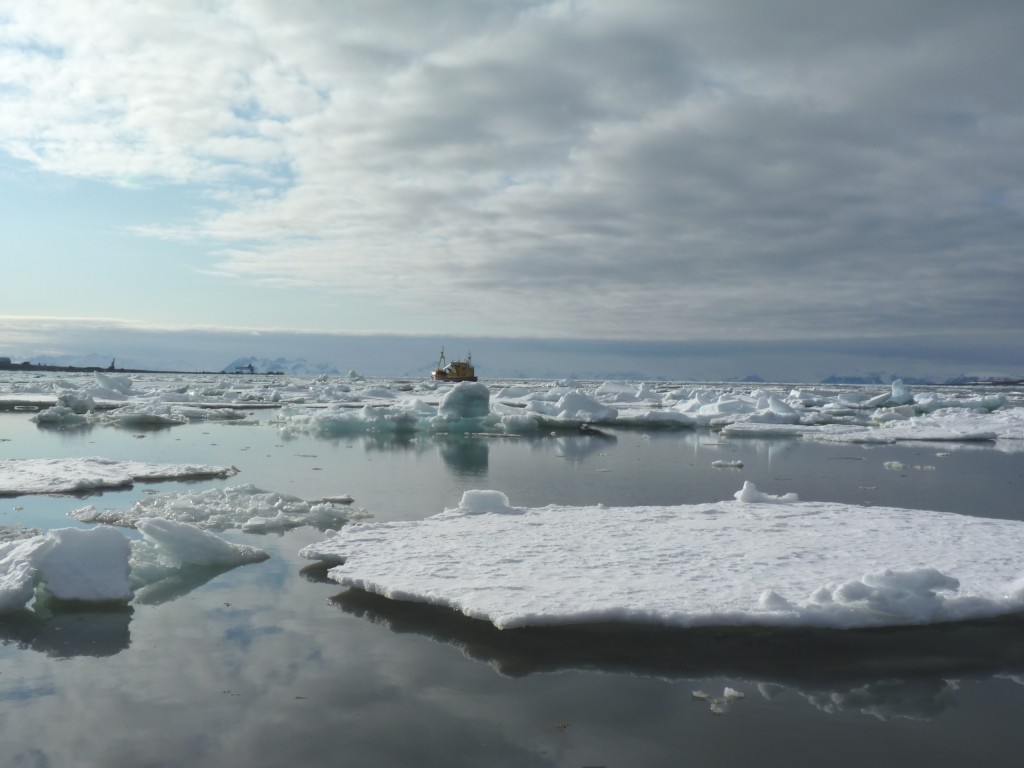

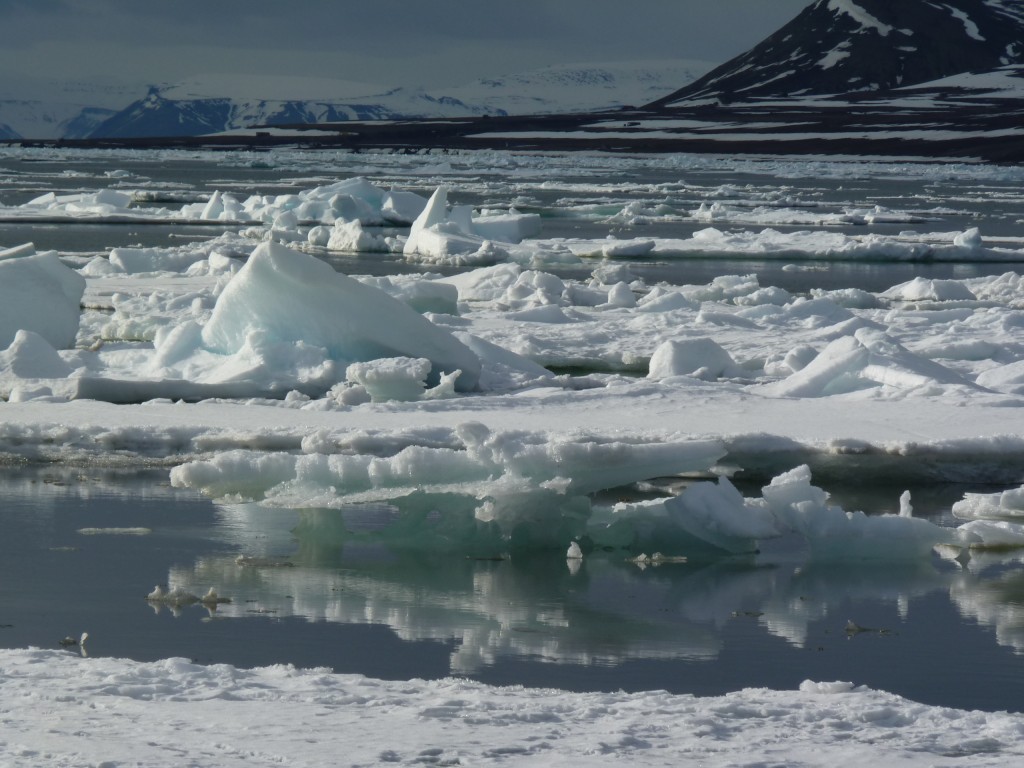
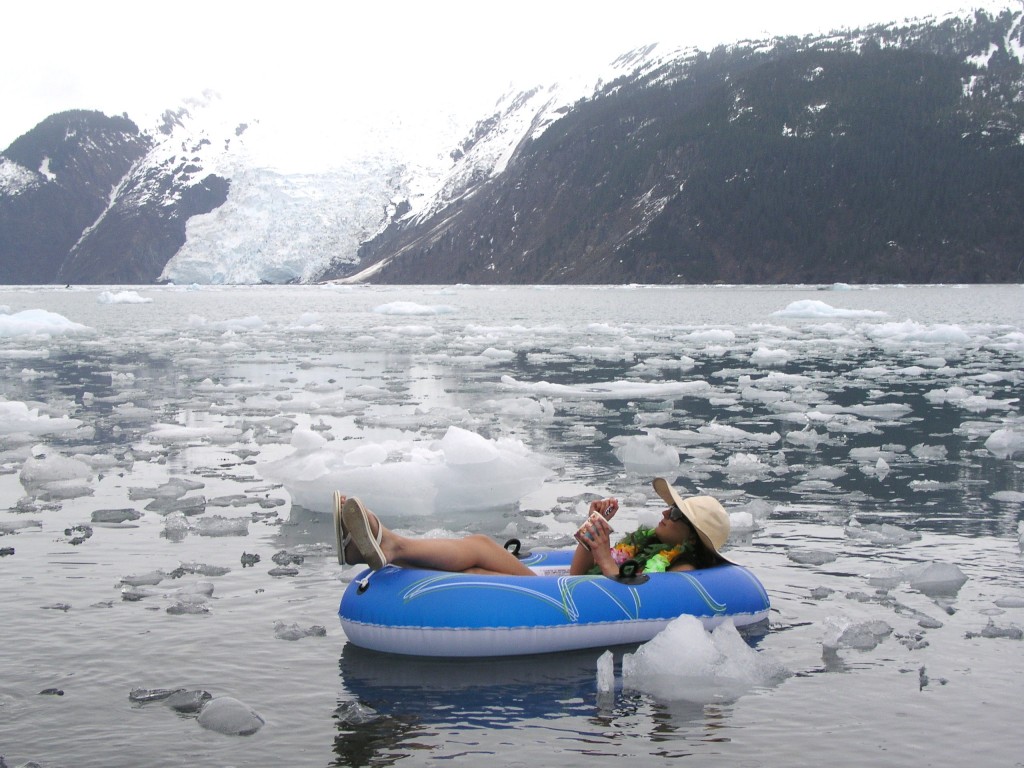

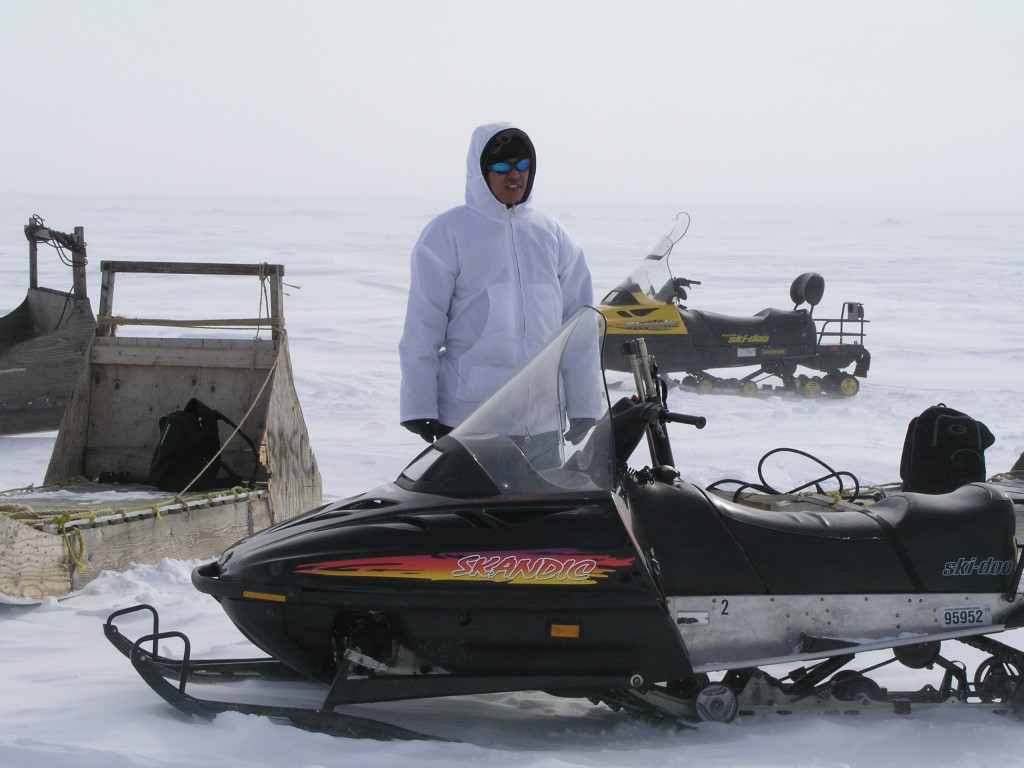

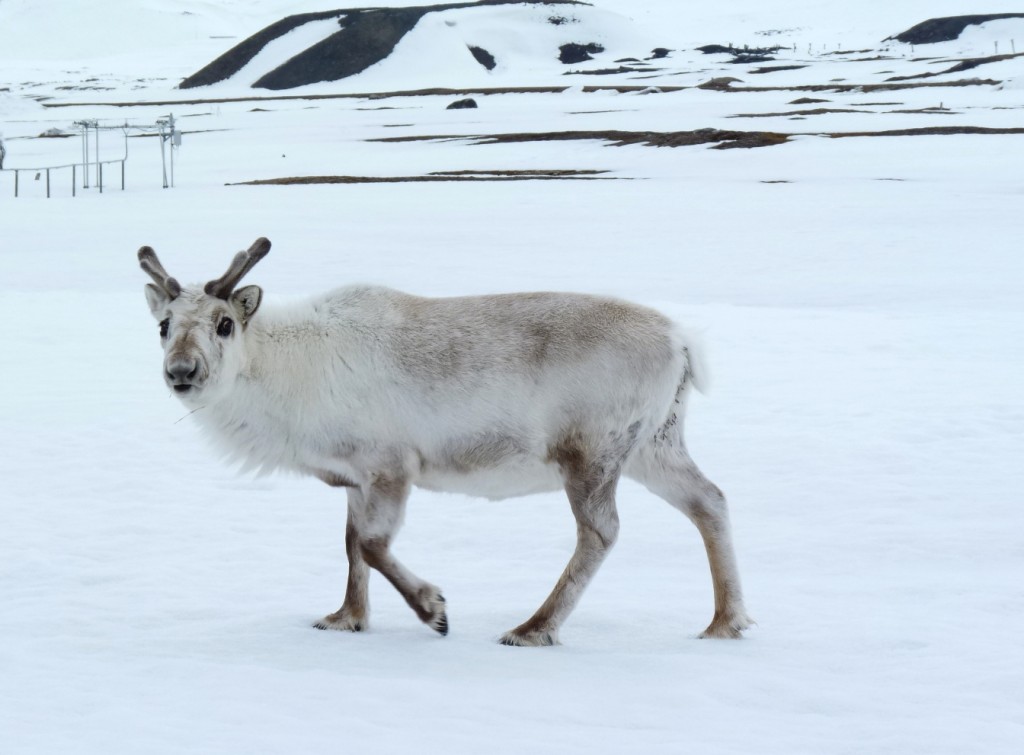
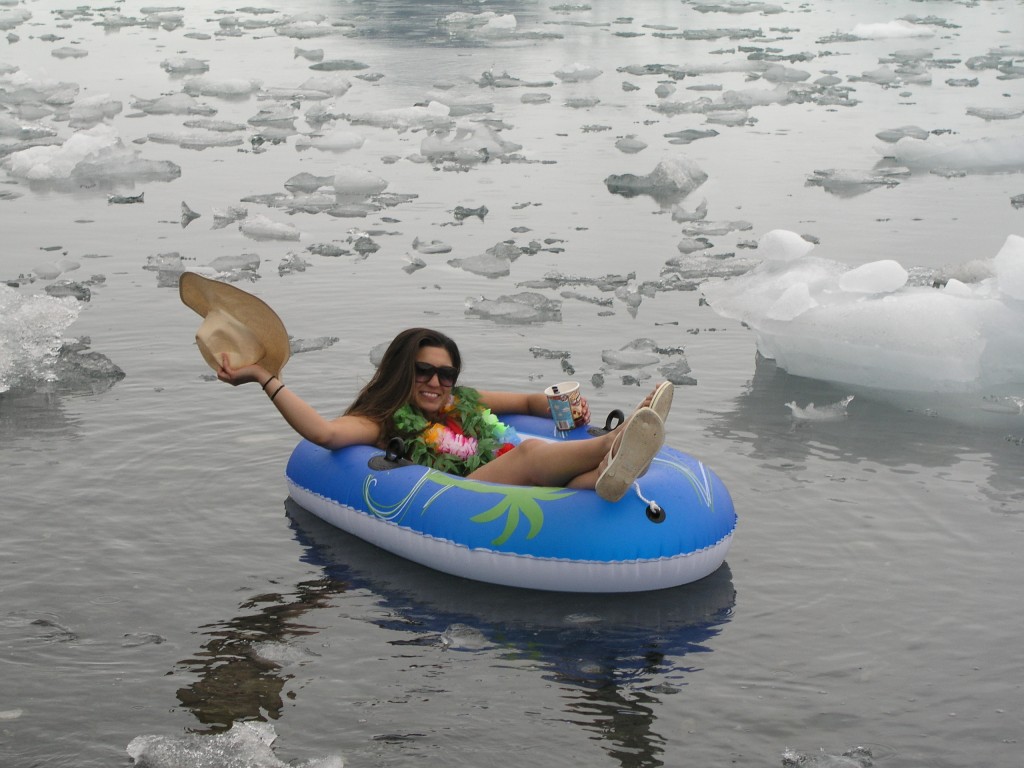
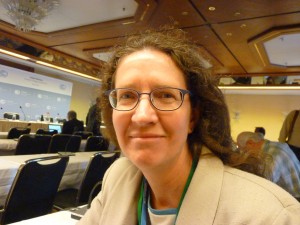

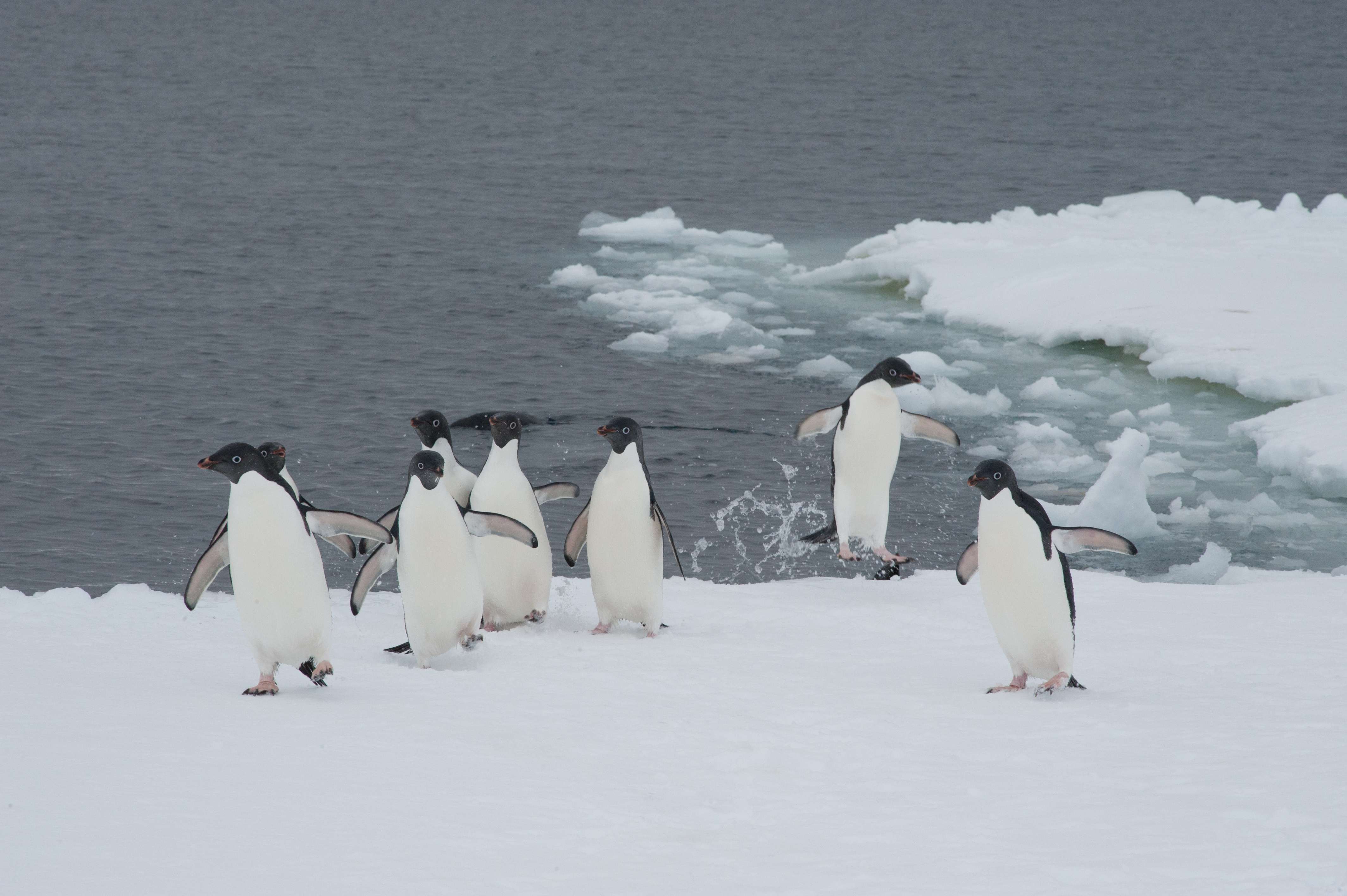

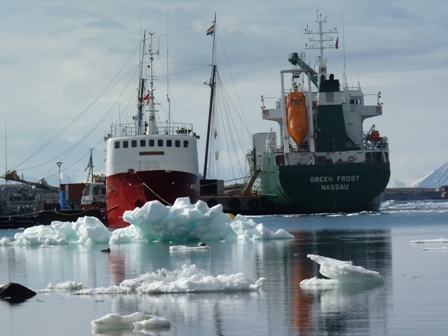


















Feedback